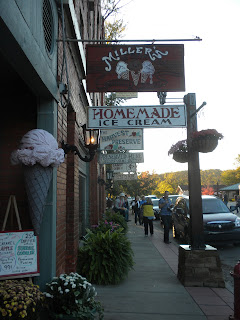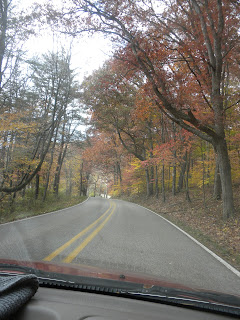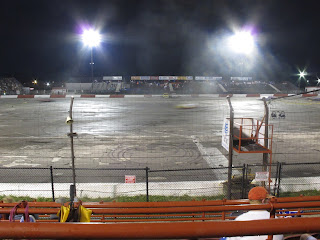Brown County, located in south-central Indiana, is renowned for its artists' studios and natural beauty. T.C. Steele, an American Impressionist painter in the late 1800s and early 1900s, is credited with establishing the County as an artists' colony, according to the Brown County Tourism website. Since then its beauty has continued to attract artists and visitors.
 |
| Brown County landscape by T.C. Steele source |
 |
| Brown County foliage |
 |
| Nashville shops |
Before I describe the Stonehenge of Indiana, I must describe the memorable journey. Driving through Brown County is a transportive experience in itself. The winding roads reveal yield to picturesque vistas at nearly every turn. Add a great playlist and the drive alone is worth the trip.
The first stop on the trip to Stonehenge was Stone Head. It is a carving from 1851 that points east to Colombus and west to Fairfax, a town that was flooded to make way for Lake Monroe. Comiskey describes it as an "unfortunate cross between a mime and Shemp of the Three Stooges." I would say that is a fair description.
 |
| Resemblance? |
From here we drove through the "prettiest valley in Brown County," passing its small farms and more fantastic foliage.
 |
| Sights from Highway 135 South |
 |
| The "Indianapolis Monthly" theme continues |
 |
| The Story Inn |
A musician played on the back porch, antique tools lined the walls and wine bottles filled with Christmas lights cast a soft glow from overhead, creating a peaceful and anachronistic atmosphere distinctively different from the typical Cracker Barrel-country kitsch.
Next door, the horse riding trail from Brown County State Park ends.
The Story Inn makes up the entirety of the village. Its isolation lends itself to beautiful nature scenes.
With a satiated appetite, the journey continued on several miles of gravel road. One last stop was left before the ascent to the Hoosier Stonehenge: a memorial to the people of Elkinsville. These people "had to leave their homes in the early 1960s when Salt Creek was dammed to create Lake Monroe," according to the article by Comiskey.
The memorial inscription reads the town was "Bathed in the shadow of Browning Mountain, a wonder in itself."
 |
| Elkinsville memorial |
After about a half hour of hiking, the circle of sandstone slabs making "Indiana's Stonehenge" finally appeared.
Regardless of the source, it is a tranquil spot conducive to quiet reflection. This spot is a far cry from the streets of Nashville crowded with Ye Olde Fudge Shoppes and seasonal tourists.













